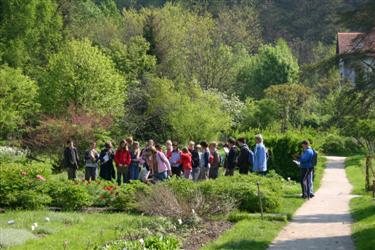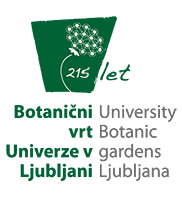
1. General tour of Botanic Garden in different seasons
2. Ecology
(1) Ecology, ecosystems and ecological conditions of plants
(2) Meadow and meadow plants
(3) Puddle, marsh and bog
(4) Tropical glasshouse – plants of tropical and subtropical sites and adjustments to their environment
(5) Plants of environments low of nutrients – carnivorous plants
(6) Forest and woody plants
(7) Trees during winter
3. Systematics
(1) Systematics
(2) How to determine plants (using simplified Idetifying keys)
4. Magnifiers
(1) Systematics
5. Plants, their use and importance for humans
(1) Plants, their use and importance for humans
(2) Medicinal plants
6. Individual work
7. Excursion to Ljubljana Moors
- General tour of Botanic Garden in different seasons
We take a look at all parts of the Botanic Garden: Arboretum, Rockery, Tropical glasshouse, Wetlands, Plant system... and learn about tipical plants, their characteristics, habitats... The Botanic Garden is more than just an interesting park. In the very center of Ljubljana, you can observe the endagered, rare or nearly extinct plants, learn about species diversity – biodiversity of Slovenia and the world, you see animals who have found refuge in similar conditions as in nature. Every season shows a different picture of the plant kingdom.
Performed throught the year. - Ecology
Each biological community is characterized by unique plants. On meadow and in plant system, we learn about meadow plants in the puddle and in pools we observe aquatic, marsh and bog plants and aquatic animals. In rockery we get to know mountain and karst plants, including many endangered and protected. In Arboretum we learn about native and exotic woody species, ecology of plants in the undergrowth, vines, importance of the forest… We learn the difference between spruce and fir, how to recognize yew, what is the difference between bush and tree… In winter we learn how to distinguish different tree species by characteristies of their bark, growth, winter buds. The Tropical glasshouse offers the possibility of learning about the tropical and subtropical ecosystems, the local climate, vegetation, adapations of plants to the ecological conditions in the tropical rain forest, interspecies relationships.
(1) Ecology, ecosystems and ecological conditions of plants
(2) Meadow and meadow plants (performed from May to September)
(3) Puddle, marsh and bog (performed from May to September)
(4) Tropical glasshouse – plants of tropical and subtropical sites and adjustments to their environment (performed throught the year)
(5) Plants of environments low of nutrients – carnivorous plants (performed throught the year)
(6) Forest and woody plants (performed from April to November)
(7) Trees during winter (performed in winter months) - Systematics
Systematics is the part of biology, that is in school benches at least interesting, but if you go into the wild, it becomes a real adventure. In Botanic Garden pupils observe live plants, they get a sense of how big it really is a Linné's contribution to the understanding of the plant kingdom. We walk among the flower beds in the plant system and learn about the diversity of plant species within the same family. In combination with general tour, learning about forest or meadow, pupils can observe differences between monocotyledonous and dicotyledonous plants, gymnosperms and angiosperms or determine plants with the simplified Identifying keys.
(1) Systematics
(2) How to determine plants (using simplified Idetifying keys) - Magnifiers
As a suplement to some lessons, offered in Botanic Garden, the use of monoocular magnifiers, is now also available. With the help of magnifiers, pupils can get to know a miniature world of plants that can not be seen by the naked eye; they can observe the inside of the blossom, parts of the blossom, and other plant organs. They can also admire the diversity in form of concealed structures in different parts of a plant.
(1) Systematics - Plants, their use and importance for humans
(1) Plants, their use and importance for humans
(2) Medicinal plants
Performed from May to October. - Individual work
Pupils get a worksheet that has a map of the garden with marked research stations on one side and drawing of a daisy with research tasks on the other. In small froups they walk around the garden using map and try to solve the tasks: observe or smell the plants, stick leaves, do the experiment, draw, look for plants with certain characteristics… and record their findings. Such a worksheet is an excellent orientation and research tool that encourages orientation on the fild, observing, sketching…
Suitable for 1-hour tour. For 2- or 3-hour tour only in combination with different themes. - Excursion to Ljubljana Moors
We briefly present the Botanic Garden, where we particulary focus on bog plants, that have become practically extincted in the Ljubljana Moors. On the Moors we visite the remains of peat bog Mali Plac, where the marshes and bog vegetation can be seen, and peatlands of Jurč, where we can see the remains of peat and observe the overgrowth. We think about the correctness of certain intervations in this endangered and protected evironments. We observe and learn about the flora and fauna on meadows, fields and in the forest, we learn about the origin and historical development of the Ljubljana Moors, talk about pile dwellers and their culture, flora and fauna in the past and nowdays, think about the reasons for the disappearance of marshes and bogs, and the prospects for their preservation. We also do the experiments with pH. If you decide for an excursion at a time when Snakeshead Lili is in ful bloom, we also visite the wet meadows in villlage Bevke and observe this protected beauty in its natural environment.
Performed from April to September.
(1) Excursion to Ljubljana Moors: visitation of the remains of a peat bog Mali Plac with its typical vegetation and peatlands of Jurč
(2) Bog plants in the Botanic Garden and the excursion to Ljubljana Moors
We recommend 3–hour excursion. 4–hour and 5-hour excursion are suitable in combination with the guided tour of the Botanic Garden.






